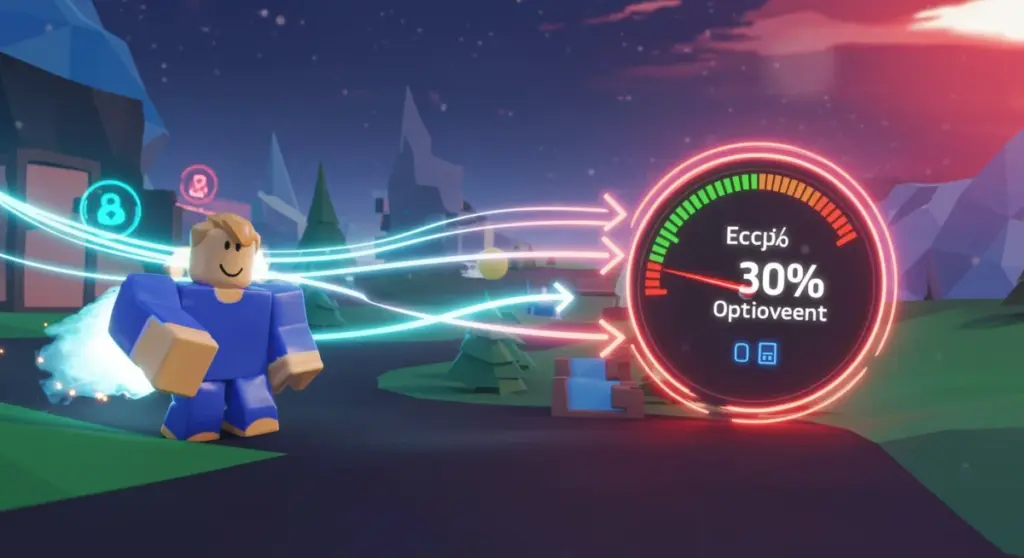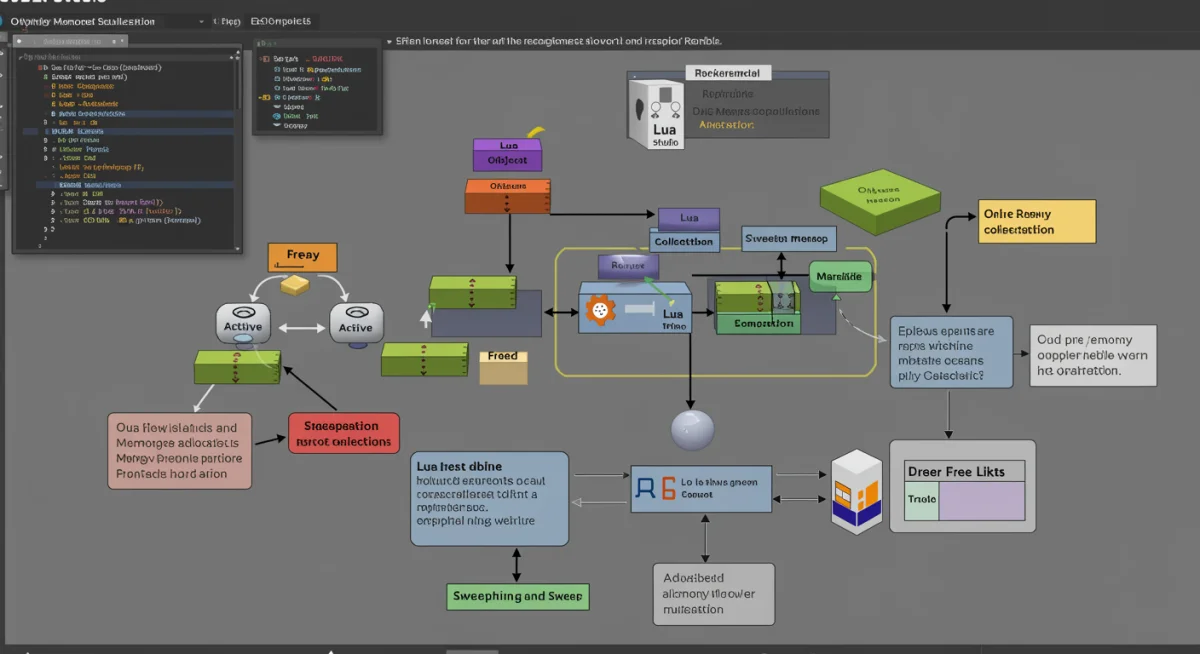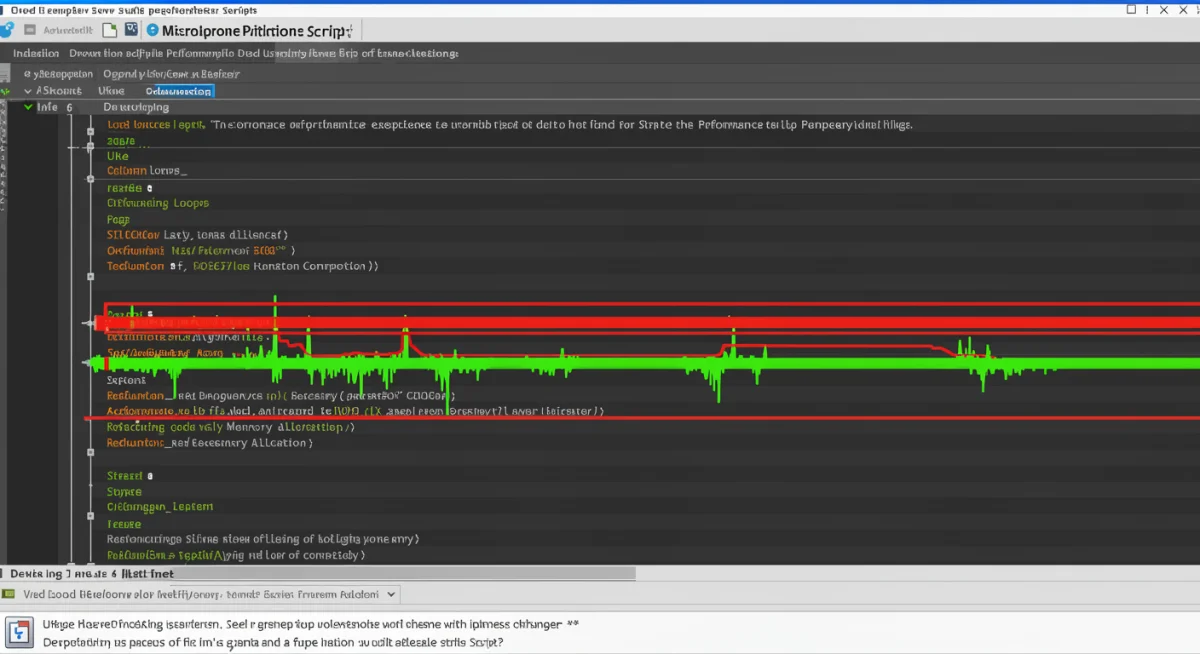Roblox Lua Optimization: Reduce Lag & Boost Performance 30%

Anúncios
Implementing effective Roblox Lua optimization strategies is paramount for developers aiming to significantly reduce lag and achieve a substantial 30% improvement in game performance and user experience.
Are you tired of your Roblox game experiencing frustrating lag, leading to a less-than-ideal player experience? In the competitive world of game development, ensuring smooth, responsive gameplay is not just a luxury; it’s a necessity. This article delves deep into advanced Roblox Lua optimization techniques designed to drastically reduce lag and elevate your game’s performance by an impressive 30%, making your creations stand out.
Understanding the Roots of Lag in Roblox Lua
Before we can effectively optimize, we must first understand what causes lag within the Roblox environment. Lag often stems from inefficient scripting, excessive resource usage, or poor network handling. Identifying these bottlenecks is the crucial first step towards creating a smoother, more enjoyable game for your players.
Many developers, especially those new to the platform, might inadvertently introduce performance issues through common scripting practices. These issues can accumulate, turning a potentially great game into a frustrating experience due to frame drops and unresponsive controls. Pinpointing these areas requires a systematic approach and understanding of how Roblox processes Lua code.
Common performance bottlenecks
- Excessive Looping: Unoptimized loops that iterate over large collections or perform complex calculations repeatedly can consume significant CPU cycles.
- Unnecessary Object Creation: Instantiating and destroying objects frequently, especially in rapid succession, can strain memory and the garbage collector.
- Poor Network Practices: Sending too much data over the network or frequent, unoptimized remote calls can lead to significant latency.
- Inefficient Physics Calculations: Complex or numerous physics-enabled parts can heavily impact performance, particularly on lower-end devices.
Understanding these common pitfalls allows developers to proactively design their games with performance in mind. It’s often easier to prevent performance issues during development than to fix them after the game is largely complete. This proactive approach is a cornerstone of effective Roblox Lua optimization.
The goal is not just to make your game run; it’s to make it run exceptionally well across a wide range of devices. This means constantly monitoring performance and being ready to refactor code when bottlenecks are identified. A well-optimized game retains players and fosters a positive community around your creation.
Efficient Scripting Practices for Reduced Lag
Efficient scripting is the bedrock of any high-performing Roblox game. It involves writing Lua code that executes quickly, uses minimal resources, and avoids common performance traps. By adopting a disciplined approach to scripting, developers can significantly reduce lag and enhance overall game responsiveness.
This section will explore several key practices that, when implemented consistently, can lead to substantial performance gains. These aren’t just theoretical concepts but actionable strategies that can be applied to both new and existing projects, contributing directly to effective Roblox Lua optimization.
Optimizing loops and iterations
Loops are fundamental to programming, but they can also be major performance hogs if not managed carefully. Always strive to minimize the number of iterations and the complexity of operations within a loop. For instance, caching frequently accessed properties or objects outside the loop can prevent redundant lookups.
-
Cache References: Store references to objects or services (e.g.,
game.Workspace,game.Players) in local variables outside loops to avoid repeated global lookups. -
Break Early: If your loop’s objective is met, use
breakto exit early, conserving computational power. -
Iterate Efficiently: When iterating over tables, prefer
ipairsfor arrays andpairsfor dictionaries. Be mindful of table size.
Beyond loops, consider the overall structure of your scripts. Avoid deeply nested conditional statements where possible, as they can increase complexity and execution time. Flat and clear code is often faster and easier to optimize.
Minimizing object creation and destruction
Constantly creating and destroying instances, especially visually complex ones, can lead to significant performance overhead. Roblox’s garbage collector works hard, but it’s more efficient if it has less to clean up. Object pooling is an excellent technique to mitigate this.
Instead of destroying an object and creating a new one when needed, maintain a pool of inactive objects. When an object is required, retrieve one from the pool and reset its properties. When it’s no longer needed, return it to the pool instead of destroying it. This reduces the burden on memory management and improves frame rates.


Another aspect of minimizing object creation is to reuse existing instances whenever feasible. For example, instead of creating new UI elements every time a message appears, update the text and visibility of a pre-existing element. These seemingly small changes accumulate to provide noticeable performance improvements, a key aspect of Roblox Lua optimization.
Optimizing Visuals and Physics for Performance
While Lua scripting is often the focus of performance discussions, visual elements and physics simulations play an equally critical role in game lag. Unoptimized models, textures, and excessive physics calculations can bring even the most well-scripted game to a crawl. Balancing visual fidelity with performance is an art that every Roblox developer must master.
This section will guide you through strategies for optimizing your game’s visual assets and physics interactions, ensuring that your world looks great without sacrificing precious frames. These techniques are vital for achieving that 30% performance boost you’re aiming for.
Streamlining visual assets
High-polygon models, large textures, and numerous transparent parts are notorious for causing performance issues. Even if your scripts are perfect, an overloaded rendering pipeline will still result in lag. The key is to be mindful of asset complexity and utilize Roblox’s tools effectively.
- Reduce Part Count: Merge smaller parts into larger ones where possible, or use mesh parts for complex shapes instead of many individual bricks.
- Optimize Textures: Use smaller resolution textures when larger ones aren’t necessary. Consider texture atlases to reduce draw calls.
- Cull Unseen Objects: Implement client-side culling for objects far from the player’s view, preventing them from being rendered unnecessarily.
Furthermore, be cautious with special effects like particles and beams. While visually appealing, they can be resource-intensive. Use them sparingly and optimize their properties (e.g., fewer particles, shorter lifespans) to keep performance in check. The goal is impactful visuals without excessive overhead, a crucial part of holistic Roblox Lua optimization.
Managing physics interactions
Roblox’s physics engine is powerful but can be demanding. Every part set to CanCollide = true or Anchored = false contributes to physics calculations. An abundance of moving, non-anchored parts or complex collision meshes can quickly overwhelm the engine.
Consider using Region3 or raycasting for collision detection where precise physics simulation is not strictly necessary. This offloads some work from the physics engine to your scripts, which can often be more efficient for specific use cases. Also, leverage CollisionGroups to prevent unnecessary interactions between specific sets of parts.
For purely visual elements that don’t need to interact physically, ensure CanCollide is set to false and Anchored is set to true. This is a simple yet highly effective way to reduce physics overhead. Actively managing physics is as important as scripting for comprehensive Roblox Lua optimization.
Network Optimization and Client-Server Communication
In a multiplayer environment like Roblox, network performance is just as critical as client-side processing. Lag often manifests as delayed actions, stuttering movement, or desynchronized game states, all of which can be traced back to inefficient client-server communication. Optimizing how your game handles data transfer is essential for a smooth online experience.
This section focuses on best practices for network communication, aiming to minimize latency and bandwidth usage. By carefully managing what data is sent, when it’s sent, and how it’s processed, you can significantly reduce network-related lag and improve overall game responsiveness.
Minimizing data transfer
Every piece of data sent between the client and server consumes bandwidth. The more data you send, the higher the latency and the greater the chance of lag. The golden rule is to send only what is absolutely necessary.
- Batch Updates: Instead of sending individual updates for every small change, batch multiple changes together and send them less frequently.
- Delta Compression: Only send the changes (deltas) in data, rather than the entire state, especially for frequently updated information.
- Data Serialization: Use efficient serialization methods to pack data tightly before transmission. Avoid sending large, uncompressed tables.
Consider the frequency of updates. Does a player’s health need to be updated on the server every millisecond, or is once every half-second sufficient? Finding the right balance between responsiveness and network load is key. This careful management of data is a cornerstone of advanced Roblox Lua optimization.
Smart event handling and remote functions
RemoteEvents and RemoteFunctions are the primary means of communication between clients and the server. However, their misuse can quickly lead to network saturation and security vulnerabilities. Design your remote calls thoughtfully.
For actions that don’t require immediate server validation (e.g., a purely cosmetic client-side effect), consider executing them locally first. For critical actions, ensure server validation is robust but efficient. Avoid spamming remote events; debounce or rate-limit calls when appropriate to prevent abuse and network overload.
Furthermore, be mindful of the amount of data passed through remote calls. Passing entire tables when only a few values are needed is inefficient. Instead, pass only the essential parameters. This disciplined approach to network communication directly contributes to a more responsive and lag-free game environment, embodying effective Roblox Lua optimization.
Leveraging Roblox’s Built-in Performance Tools
Roblox Studio provides powerful tools specifically designed to help developers identify and resolve performance bottlenecks. These tools offer insights into CPU usage, memory consumption, and network activity, guiding you directly to the areas of your game that need attention. Ignoring them is akin to trying to fix a car without a diagnostic tool.
Mastering these tools is not just about understanding their features; it’s about integrating them into your regular development workflow. Regular profiling and debugging can preemptively catch issues before they impact your players, ensuring continuous Roblox Lua optimization.
The microprofiler: your performance detective
The MicroProfiler is an invaluable tool for deep-diving into your game’s performance. It provides a detailed breakdown of what your game is doing frame by frame, highlighting where CPU time is being spent. Learning to interpret its output is crucial for targeted optimization.
- Identify Spikes: Look for sudden, large spikes in frame time, which indicate a performance bottleneck.
- Analyze Categories: The MicroProfiler categorizes operations (e.g., Physics, Script, Render). Focus on the categories consuming the most time.
- Trace Calls: Drill down into specific calls within the Script category to pinpoint which functions or lines of code are causing slowdowns.
Running the MicroProfiler on different devices and under various conditions (e.g., with many players, during intense action) can provide a comprehensive view of your game’s performance profile. This data-driven approach is far more effective than guesswork for any serious Roblox Lua optimization effort.
Memory usage and garbage collection
Excessive memory usage can lead to stuttering and crashes, especially on mobile devices. Roblox Studio’s Developer Console (F9) provides a ‘Memory’ tab that shows current memory consumption by various categories (e.g., Instances, Textures, Scripts). Monitor this regularly.


Understanding Lua’s garbage collection mechanism is also important. While Lua handles memory automatically, inefficient practices (like creating many short-lived objects) can force the garbage collector to work harder, causing temporary hitches. Aim for a balance where objects are reused or explicitly cleaned up when no longer needed, reducing the burden on the automatic collector.
By diligently using these built-in tools, developers can move beyond anecdotal evidence and make informed decisions about where to focus their optimization efforts, ensuring a truly impactful Roblox Lua optimization strategy.
Advanced Lua Scripting Techniques for Peak Performance
Beyond the fundamental best practices, there are several advanced Lua scripting techniques that can wring out every last bit of performance from your code. These methods often involve a deeper understanding of Lua’s internals and how Roblox processes scripts, allowing for highly targeted optimizations. Implementing these can be the difference between good performance and exceptional performance.
This section delves into some of these more sophisticated strategies, offering insights that can further refine your game’s efficiency and contribute significantly to achieving that ambitious 30% performance improvement. These are the nuances of true Roblox Lua optimization.
Table and string optimization
Tables are ubiquitous in Lua, and strings are frequently used. Optimizing how you handle these can have a surprising impact. For tables, pre-allocating size if you know it can reduce reallocations. When inserting or removing elements frequently, consider using linked lists or other data structures more suited for such operations than simple arrays.
-
String Concatenation: Prefer
string.format()or table concatenation withtable.concat()for building strings over repeated..operations. - Table Caching: Cache frequently accessed table fields in local variables to speed up access.
- Avoid Global Lookups: When possible, use local variables to store functions or modules, as global lookups are slower.
Even seemingly minor optimizations in how you handle strings and tables can add up, especially in scripts that execute frequently or process large amounts of data. These micro-optimizations are a testament to the depth of Roblox Lua optimization possibilities.
Event-driven programming and signal handling
Roblox’s event-driven architecture is powerful, but it’s crucial to use it wisely. Connecting too many functions to the same event, or connecting to events that fire extremely frequently without proper filtering, can quickly lead to performance degradation.
Consider using custom events or signals for communication between modules instead of relying solely on Roblox’s built-in events for every interaction. This gives you more control over when and how events are fired, allowing for more precise management of script execution. Disconnect signals when they are no longer needed to prevent memory leaks and unnecessary function calls.
For example, if an enemy AI only needs to update its pathfinding every few seconds, don’t connect it to RunService.Heartbeat. Instead, use a timer or a custom event that fires at the appropriate interval. This thoughtful approach to event handling is a hallmark of highly optimized Roblox games and a core component of effective Roblox Lua optimization.
Maintaining Performance: Continuous Monitoring and Updates
Achieving a 30% performance improvement through Roblox Lua optimization is a significant milestone, but it’s not a one-time task. Game development is an iterative process, and new features, content, or even changes in the Roblox engine itself can introduce new performance challenges. Continuous monitoring and regular updates are essential to maintain peak performance over time.
This final section emphasizes the importance of integrating performance checks into your development lifecycle, ensuring that your game remains fast and responsive for your players, regardless of future updates or expansions. A proactive approach guarantees long-term success.
Regular performance audits
Just as you test for bugs, you should regularly audit your game for performance regressions. Schedule periodic checks using the MicroProfiler and Developer Console, especially after implementing major new features or content. This helps catch issues early before they become deeply embedded or impact a large player base.
- Automated Testing: Where possible, implement automated performance tests that simulate player activity and flag any significant drops in frame rate or increases in memory usage.
- Player Feedback: Pay close attention to player reports of lag or poor performance. They are often the first to notice issues that might escape your internal testing.
- Cross-Device Testing: Test your game on a variety of devices, from high-end PCs to older mobile phones, to ensure consistent performance across your target audience.
These audits shouldn’t just be about fixing problems; they should also be about identifying opportunities for further optimization. Even small, incremental improvements can add up over time, contributing to an overall superior gaming experience and sustained Roblox Lua optimization.
Staying updated and adaptive
The Roblox platform is constantly evolving. New features are added, old ones are deprecated, and the underlying engine receives regular updates. Staying informed about these changes is crucial, as they can sometimes offer new optimization opportunities or necessitate changes to existing code.
Participate in developer forums, read release notes, and experiment with new tools or APIs. An adaptive development mindset means being ready to refactor or rethink parts of your game’s architecture when better, more efficient methods become available. This continuous learning and adaptation are fundamental to long-term performance success in Roblox game development. By embracing these principles, you ensure your game not only achieves but also maintains its optimized state, solidifying your commitment to effective Roblox Lua optimization.
| Key Optimization Area | Brief Description |
|---|---|
| Efficient Lua Scripting | Minimize loops, cache references, and reuse objects to reduce CPU and memory strain. |
| Visual & Physics Optimization | Reduce part count, optimize textures, and manage physics interactions carefully to lighten rendering load. |
| Network Communication | Batch data, use delta compression, and optimize remote calls to minimize latency and bandwidth. |
| Tool-Driven Analysis | Utilize MicroProfiler and Developer Console to identify and resolve performance bottlenecks systematically. |
Frequently Asked Questions About Roblox Lua Optimization
The most common cause of lag is often inefficient Lua scripting, including excessive loops, unnecessary object creation, or poorly managed network communication. Unoptimized visual assets and complex physics calculations also contribute significantly to performance issues, making games less enjoyable for players.
The MicroProfiler is a powerful tool in Roblox Studio that provides a detailed, frame-by-frame breakdown of where CPU time is being spent. It helps developers pinpoint specific script functions, physics calculations, or rendering processes that are causing performance bottlenecks, enabling targeted optimization efforts.
Reusing existing objects through techniques like object pooling is generally better for performance than constantly creating and destroying new instances. This reduces the workload on the garbage collector and minimizes memory allocations, leading to smoother gameplay and fewer hitches, especially during intense action.
Network optimization is crucial as it minimizes the amount of data transferred between clients and the server. By batching updates, using delta compression, and optimizing remote calls, developers can reduce latency, prevent network saturation, and ensure a more responsive and synchronized multiplayer experience for all players.
While results vary based on the initial state of your game, implementing a comprehensive set of Lua and asset optimization techniques can lead to significant improvements. Many developers report achieving a 30% or even higher boost in game performance, resulting in a much smoother and more enjoyable player experience.
Conclusion
Achieving optimal performance in your Roblox games is a continuous journey that demands a blend of efficient Lua scripting, careful asset management, smart network practices, and diligent use of Roblox’s built-in diagnostic tools. By systematically addressing common causes of lag and embracing advanced optimization techniques, you can transform your game into a fluid, responsive experience that captivates players. The pursuit of a 30% performance boost is not merely about numbers; it’s about delivering a superior, lag-free environment that maximizes player enjoyment and retention. Commit to these strategies, and watch your Roblox creations thrive.





